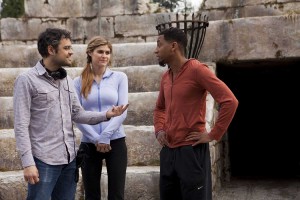
With Marc Guggenheim’s screenplay for Percy Jackson: Sea of Monsters, based upon the novel Percy Jackson and the Olympians: The Sea of Monsters by Rick Riordan, Freudenthal knew he would have to tackle the myriad visual effects which the story required. According to Freudenthal, his ability to incorporate the numerous visual effects became a matter of working closely with his cast and crew, starting with the actors. “What you learn is that a reaction or an actor’s emotion when faced with something is as important as the visual effect, maybe even more so,” the director said. “A human face often times tells you the intensity of what they are experiencing.”
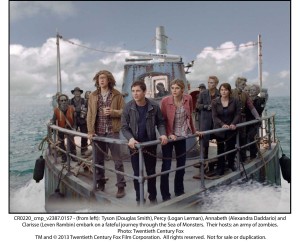 Freudenthal started planning the film in late 2011, later locking locations and starting to shoot at the end of April 2012, wrapping early August. This new Percy Jackson bursts into action with a high-energy sequence featuring its young stars competing on an obstacle tower. Even though there was digital wire removal of the young actors on the tower, the scene was all shot and achieved practically. “Claude Paré built it,” said Freudenthal of the film’s production designer. “It was inspired by an element in the books with a climbing wall at camp. What kind of cool modular tower can we build to have movement and action but introduce everyone key in the film? It was a fun fast-paced way of getting everyone in to the film.”
Freudenthal started planning the film in late 2011, later locking locations and starting to shoot at the end of April 2012, wrapping early August. This new Percy Jackson bursts into action with a high-energy sequence featuring its young stars competing on an obstacle tower. Even though there was digital wire removal of the young actors on the tower, the scene was all shot and achieved practically. “Claude Paré built it,” said Freudenthal of the film’s production designer. “It was inspired by an element in the books with a climbing wall at camp. What kind of cool modular tower can we build to have movement and action but introduce everyone key in the film? It was a fun fast-paced way of getting everyone in to the film.”
Of the actual obstacle tower, built on a tennis court in Burnaby Park, Freudenthal explained how the concept originated in the art department. “We had several versions,” he noted. “They could not build a structure that big that moves that much. You always have to compromise to some degree. We had some interesting moments shooting close-ups 60 feet in the air. It was all stunt people and one wide shot with one digi-double that falls all the way down. Everything else was accomplished with a great team of stunt guys. We didn’t have time to previz this. It was pretty tightly storyboarded. We did performance elements and some stunts, and a second-unit team did stunts over a weekend.”
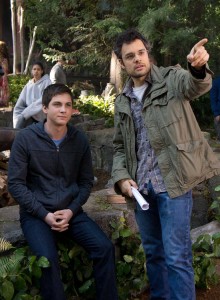
For all of Percy Jackson’s effects characters and sequences, Dan Kaufman was the overall visual effects supervisor while Freudenthal’s Cal Arts classmate and friend Ryan Donoghue was the animation director on the film. Donoghue did the character animation on the bull, the Hippocampus, the Manticore (scorpion/lion creature) and the sea monster Charybdis while Bill Westenhofer supervised effects sequences at Rhythm and Hues. One of the R&H’s notable design and animation high points is with the aforementioned Hippocampus, a cross between a horse and a sea creature. “They designed the creature as a rendered 2D illustration that I fell in love with — they took it from concept to screen,” said Freudenthal. “The film was split up to several vendors. Kronos [the climatic fire demon] was done by Moving Picture Company in London. MPC Vancouver did the Cyclops in the cave, Polyphemus. Method Studios did the transformation into the cave. For the Oracle, a stained glass sequence was done by Embassy.”
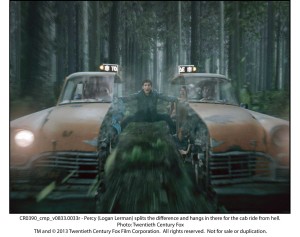 Freudenthal had a definitive strategy for shooting his background plates into which characters such as the Hippocampus were integrated. In the first scene with the creature, the main characters interact with it on an oceanic dock. “I wanted to shoot as much location and as little greenscreen,” Freudenthal explained. Once the characters board the creature, their ride upon it takes place on a green-colored device atop a gimbal in a studio. Plates for that sequence were shot at Lake Pontchartrain in New Orleans and with a second unit at a lake in British Columbia. “The plates are pulled apart and texture mapped onto digital environments to allow us to move the camera as we wanted,” the director said. “Digital environments were made out of those plates. The Hippocampus was added with digital artifacts.”
Freudenthal had a definitive strategy for shooting his background plates into which characters such as the Hippocampus were integrated. In the first scene with the creature, the main characters interact with it on an oceanic dock. “I wanted to shoot as much location and as little greenscreen,” Freudenthal explained. Once the characters board the creature, their ride upon it takes place on a green-colored device atop a gimbal in a studio. Plates for that sequence were shot at Lake Pontchartrain in New Orleans and with a second unit at a lake in British Columbia. “The plates are pulled apart and texture mapped onto digital environments to allow us to move the camera as we wanted,” the director said. “Digital environments were made out of those plates. The Hippocampus was added with digital artifacts.”
In the Hermes sequence, with the character played by Nathan Fillion, Freudenthal designed the shots with set extensions in mind. “I shot on a partial set on a paper factory in Vancouver,” he said. “We covered the walls with green and extended the sets. That was precisely pre-planned. We knew the number of extensions we could do. I had to shoot the scene with that number in mind. It’s not a freewheeling situation. Everything is prepped and pre-determined.”
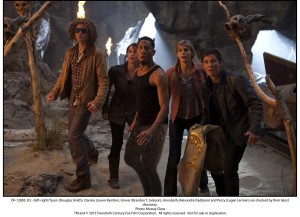 Surely, having a background in animation from Cal Arts assisted Freudenthal in his approach to an effects-heavy film such as Percy Jackson. “You learn an economy in storytelling,” he revealed. “In animation, every shot better have a reason to be there. To translate that sensibility to a visual effects film, let’s focus on the shot we need and make that really cool. It keeps the movie at a certain pace; it never lingers. You wish you can do more, but in the end, you have to make do with what you have.”
Surely, having a background in animation from Cal Arts assisted Freudenthal in his approach to an effects-heavy film such as Percy Jackson. “You learn an economy in storytelling,” he revealed. “In animation, every shot better have a reason to be there. To translate that sensibility to a visual effects film, let’s focus on the shot we need and make that really cool. It keeps the movie at a certain pace; it never lingers. You wish you can do more, but in the end, you have to make do with what you have.”
Due to the pre-planning required, Freudenthal maximized principal photography. “We might have shot 50 days on location — this was a very fast schedule,” he said. “We were always running and gunning. The producers and studio rightfully assess what the movie can achieve and build the timing allotted for that accordingly. It puts me in an ambitious position. The director wants to achieve as much as possible and get more bang for our buck. For a feature of this technical nature, it was pretty quick. There was always a good energy and urgency to the whole operation.”
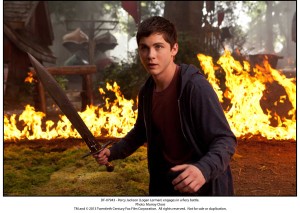 With the cave sequence for Polyphemus shot on a stage in Vancouver with several greenscreen extensions, the climactic finale was shot in an abandoned Six Flags park in New Orleans, a remnant from Hurricane Katrina. “Bill Bannerman, one of our producers, a co-producer and line producer, found this thing online,” said Freudenthal. “It looked completely haunted and weird. We went there and Six Flags had just walked away from it, partially taken apart. These giant roller coasters and structures are all intact. It was important to find a visual backdrop for the ending.”
With the cave sequence for Polyphemus shot on a stage in Vancouver with several greenscreen extensions, the climactic finale was shot in an abandoned Six Flags park in New Orleans, a remnant from Hurricane Katrina. “Bill Bannerman, one of our producers, a co-producer and line producer, found this thing online,” said Freudenthal. “It looked completely haunted and weird. We went there and Six Flags had just walked away from it, partially taken apart. These giant roller coasters and structures are all intact. It was important to find a visual backdrop for the ending.”
As principal photography wrapped a year before the film’s release, Percy Jackson was in post since that time, a period that Freudenthal called “long and arduous.” Through that time, Freudenthal worked side-by-side with longtime action film editor Mark Goldblatt. “I can’t say enough awesome things about Mark. He’s so great and the nicest human being,” the director said. “There’s a period where you are finding your movie – putting the pieces together, making changes. The thing about a visual effects movie, effects have to start early.”
During Percy Jackson’s post period, Freudenthal and Goldblatt would craft the footage, often going back to the visual effects teams to enhance shots. “The bull was not as modular a character when we shot the scene,” Freudenthal explained. “All of the things we came up with when we were looking at the first pass of animation. In essence, the design process continues. That’s what makes it elaborate.”
Surely, like other effects-intensive films, the locked release date is the constant focus for postproduction craftspeople. “At the end, it’s a race to the finish line,” said the director. “It’s like a vortex that is spinning faster and faster. Add to that 3D – the studio, after viewing three weeks of dailies, said it should be in 3D. From that moment on, we were very aware that it was going to be in 3D and acted accordingly. The 3D process is it’s own big visual effect that you have to finish, do a depth pass, do a paint pass. Visual effects are put in a 3D pipeline and converted as well.” Stereo D handled all of Percy Jackson’s 3D conversion as they had done on recent films including Titanic.
For Freudenthal’s next venture, he has several projects on the horizon that are each a departure from his feature work to date. “I’ve done three family movies in a row,” he said. “I love that genre – a good sense of humor combined with open emotions. I could also see myself doing something a little more practical where you don’t have to watch for visual effects in every shot that you’re doing. I think it’s a fun world, but I could just as well see myself tackling something that relies on performances – a big idea rather than a big movie.”





